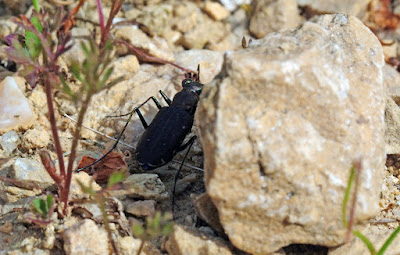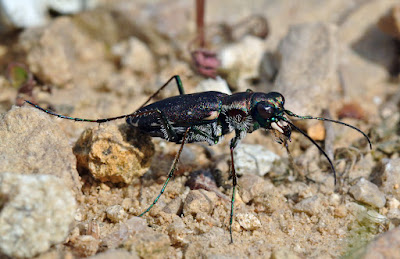"He who marvels at the beauty of the world in summer will find equal cause for wonder and admiration in winter."
― John Burroughs
It wasn't completely indiscriminate, as I had at least one target species in mind. I started my morning by checking a Punctured Tiger Beetle spot adjacent to the Pheasant Branch Creek Corridor. Sure enough, they were present and in decent numbers. Back in 2018, the Great August Flood totally destroyed this path and the nearby pond when the slope caved in from rushing water, sending all the sediment downstream. I thought for sure that was going to spell the end of the site for this species, but they endured. Perhaps eggs were oviposited far enough away to avoid destruction. But it could also be the case that after the path was restored it merely attracted the beetles once again.
Scientifically known as Cicindela punctulata for the pits that are a feature of the microscuplture on their elytra, Punctured Tiger Beetles are prolific and can be found just about anywhere. One of the most widely ranging tiger beetles in North America, I've observed them at woodlands, prairies, savannas, sandy areas, gravel, parking lots, sidewalks, etc. Though some emerge in June, I think of them as a July and August beetle.
The Punctured Tiger Beetles I find in southern Wisconsin are generally very dark with hints of iridescent green, blue, and purple. If any have maculations, they're usually reduced to small spots and short lines. If you look closely, many from this site have a tan-colored shoulder mark just behind the thorax.
The comfortable temperature of a summer morning is brief. Already beginning to breach the barrier between warm and hot, the beetle above is seen here using a larger stone's shadow to bring its body temperature down. After a few minutes, it sprang back into action ready to resume hunting. I observed one go after an ant, but the smaller insect slipped underneath a stone and escaped the mandibles of death.
So this was interesting. To me it looked like the beetle was using its mandibles to munch the base of a tiny plant ― a way to extract a bit of moisture, perhaps? I've observed tiger beetles drinking water at the shore's edge, and also suck up blood from a dead fish. Remember that?
And some nice portraits to conclude the Punctured Tiger Beetle mission ...
And then onto the Bug Hunt ...
Treefrogs aren't necessarily easy to find even when croaking. Effective insecting necessitates careful inspection of various host plants ― this is how I often find the dapper little frogs. Stoically unmoved, I took three exposures and moved on. I have no idea what they're thinking, but I have in the past overstayed my welcome with them. I like to think by getting my part of the encounter over with as quickly as possible they're left with the impression that their camouflage worked once again.
The secondary trails are accessed at various locations from the main commuter artery. I prefer exploring these trails simply for avoidance of interruptions, but I don't mind the occasional inquisition. Curious onlookers see me at work and when asked I respond "insects" and their curiosity seems satiated. Seldom does an inquiry go beyond this. I wonder what they imagine I'm photographing and if they're aware of the amazing entomological gems the creek corridor offers the naturalist.
And then anything and everything I get get my macro lens focused on. Here we have a Banded Hairstreak, some Milkweed Beetles, a Grape Root Worm Beetle, Stiletto Flies, Stilt-legged Fly, Filmy Dome Spider with prey, Running Crab Spider (missing a limb), Two-marked Treehopper, Red-banded Leafhoppers, and a Meadow Spittlebug. Each critter presents its own challenge ― some are docile but can hide on the underside of leaves, while others are obvious but frenetic.
The 2018 August flood also left many large sand deposits along the creek corridor, which has rendered great habitat for Bronzed Tiger Beetles. My primary tiger beetle haunts generally have at least 5 species, but having 3 practically in my backyard provides convenient access for a quick fix!
And there was a lot of copulation going on, which is the point. Reproductive seasons can be brief and one calamity or another can quickly render their efforts futile. Nature is red in tooth and claw and the struggle for existence is real. Nature ― all on its own ― has equipped itself with means, processes, strategies, and adaptabilities to render endless varieties that ensure life will continue to thrive on this planet for at least another few billion years. And once it's gone, it's gone for eternity. The living creatures I share with you on this blog are unique in all the Universe. To be sure, there's probably life out there on other planets far away in our galaxy and beyond. It's one thing to imagine just how alien they might seem, but while here on Earth you can find them right in your own backyard.
All images © 2022 Mike McDowell































